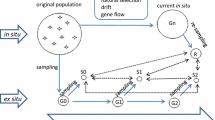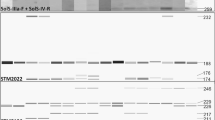Abstract
Genetic characterization of germplasm is important for setting objective guidelines for conservation. One common problem found in genebanks is determining the value of populations with insufficient or unreliable data regarding their geographic origin. In this study, a genetic analysis based on RAPD markers was conducted to characterize a `mystery' population of Solanum sucrense, a polysomic tetraploid potato (2n=4x=48), for which adequate documentation was lacking. The comparative analysis of genetic similarities between this mystery population and each one of 30 other S. sucrense populations in the genebank revealed that all populations within this species, including the mystery population, are significantly different from being duplicates, and are therefore worthy of separate conservation. RAPD markers also distinguished the mystery population from closely related tetraploid species S. oplocense, S. gourlayi and S. tuberosum ssp. andigena, suggesting that it is also not a duplicate of a population of these species. If RAPDs can clearly differentiate populations within highly heterogeneous tetraploids like S. sucrense, they should be generally useful for determining germplasm organization within potato species.
Similar content being viewed by others
References
Astley, D. & J.G. Hawkes, 1979. The nature of the Bolivian weed potato species Solanum sucrense Hawkes. Euphytica 28: 685–696.
Bamberg, J.B., M.W. Martin, J.J. Schartner & D.M. Spooner, 1996. Inventory of tuber-bearing Solanum species. Catalog of Potato Germplasm-1996. NRSP-6, Sturgeon Bay, WI.
Bonierbale, M.W. & R.L. Plaisted, 1993. A test of maximum heterozygosity hypothesis using molecular markers in tetraploid potatoes. Theor. Appl. Genet. 86: 481–491.
Bretting, P.K. & M.P. Widrlechner, 1995. Genetic markers and plant genetic resources management. Plant Breed. Rev. 13: 11–86.
del Rio, A.H., J.B. Bamberg & Z. Huaman, 1997a. Assessing changes in the genetic diversity of potato genebanks. 1. Effects of seed increase. Theor. Appl. Genet. 95: 191–198.
del Rio, A.H., J.B. Bamberg, Z. Huaman, A. Salas & S.E. Vega, 1997b. Assessing changes in the genetic diversity of potato genebanks. 2. In situ vs ex situ. Theor. Appl. Genet. 95: 199–204.
Demeke, T., L.M. Kawchuk & D.R. Lynch, 1993. Identification of potato cultivars and clonal variants by random amplified polymorphic DNA analysis. Am. Potato J. 70: 561–570.
Dunbier, M.W. & E.T. Bingham, 1975. Maximum heterozygosity in alfalfa: results using haploid-derived autotetraploids. Crop Sci. 15: 527–531.
Dweikat, I., S. Mackenzie, M. Levy & H. Ohm, 1993. Pedigree assessment using RAPD-DGGE in cereal crop species. Theor. Appl. Genet. 85: 497–505.
Francisco-Ortega, J., H.J. Newbury & B.V. Ford-Lloyd, 1993. Numerical analysis of RAPD data highlight the origin of cultivated tagasaste (Chamaecytisus proliferus ssp. palmensis) in the Canary Islands. Theor. Appl. Genet. 87: 264–270.
Hawkes, J.G. & J.P. Hjerting, 1989. The Potatoes of Bolivia. Their Breeding Value and Evolutionary Relationships. Clarendon Press, Oxford.
Hormaza, J.I., L. Dollo & V.S. Polito, 1994. Determination of relatedness and geographical movements of Pistacia vera (Pistachio: Anacardiaceae) germplasm by RAPD analysis. Econ. Bot. 48: 349–358.
Hosaka, K. & R.E. Hanneman, Jr., 1991. Seed protein variation within accessions of wild and cultivated potato species and inbred Solanum chacoense. Potato Res. 34: 419–428.
Hosaka, K., M. Mori & K. Ogawa, 1994. Genetic relationships of Japanese potato cultivars assessed by RAPD analysis. Am. Potato J. 71: 535–546.
Kresovich, S. & J.R. McFerson, 1992. Assessment and management of plant genetic diversity: considerations of intra-and inter-specific variation. Field Crops Res. 29: 185–204.
Marcucci-Poltri, S., M.C. Martinez & S. Hopp, 1998. Genetic relationships in the genus Solanum subsection Potato using RFLP, AFLP and SSR markers (Abstr.). In: VI Plant and Animal Genome Meeting San Diego, CA.
Mendiburu, A.O. & S.J. Peloquin, 1977. The significance of 2n gametes in potato breeding. Theor. Appl. Genet. 49: 53–61.
Michelmore, R.W., I. Paran & R.V. Kesseli, 1991. Identification of markers linked to disease-resistance genes by bulked segregant analysis: A rapid method to detect markers in specific genomic regions by using segregating populations. Proc. Natl. Acad. Sci. USA 88: 9828–9832.
Milbourne, D., R. Meyer, J.E. Bradshaw, E. Baird, N. Bonar, J. Provan, W. Powell & R. Waugh, 1997. Comparison of PCR-based marker systems for the analysis of genetic relationships in cultivated potato. Mol. Breed. 3: 127–136.
Newbury, H.J. & B.V. Ford-Lloyd, 1993. The use of RAPD for assessing variation in plants. Plant Growth Reg. 12: 43–51.
Nienhuis, J., J. Tivang & P. Skroch, 1994. Analysis of genetic relationships among genotypes based on molecular marker data. In: Proceedings of the Symposium: Analysis of molecular marker data. ASHS, Corvallis, OR.
Rohlf, F.J., 1989. NTSYS-PC Numerical taxonomy and multivariate analysis system. Exeter Publ, Setauket, NY.
Smith, J.J., J.S. Scott-Craig, J.R. Leadbetter, G.L. Bush, D.L. Roberts & D.W. Fulbright, 1994. Characterization of random amplified polymorphic DNA (RAPD) products from Xanthomonas campestris and some comments on the use of RAPD products in phylogenetic analysis. Mol. Phyl. Evol. 3: 135–145.
Spooner, D.M. & R.G. van den Berg, 1992. An analysis of recent taxonomic concepts in wild potatoes (Solanum sect. Petota). Genet Res. Crop Evol. 39: 23–37.
Spooner, D.M., D.S. Douches & A. Contreras, 1992. Allozyme variation within Solanum sect. Petota, Ser. Etuberosa (Solanaceae). Am. J. Botany 79: 467–471.
Spooner, D.M., R.G. van den Berg & J.B. Bamberg, 1995 Examination of species boundaries of Solanum series Demissa and potentially related species in series Acaulia and series Tuberosa (sect. Petota). Syst. Bot. 20: 295–314.
Steele, R.G.D. & J.H. Torrie, 1980. Principles and Procedures of Statistics, 2nd edition. McGraw-Hill, New York, NY.
Tinker, N.A., M.G. Fortin & D.E. Mather, 1993. Random amplified polymorphic DNA and pedigree relationships in spring barley. Theor. Appl. Genet. 85: 976–984.
Ugent, D., 1970. The Potato: what is the origin of this important crop plant, and when did it first become domesticated? Science 170: 1161–1166.
van den Berg, R.G., J.T. Miller, M.L. Ugarte, J.P. Kardolus, J. Villand, J. Nienhuis & D.M. Spooner, 1998. Collapse of morphological species in the wild potato Solanum brevicaule complex (Solanaceae: Sect. Petota). Am. J. Bot. 85: 92–109.
Virk, P.S., B. Ford-Lloyd, M. Jackson & H.J. Newbury, 1995a. Use of RAPD for the study of diversity within plant germplasm collections. Heredity 74: 170–179.
Virk, P.S., H.J. Newbury, M.T. Jackson & B.V. Ford-Lloyd, 1995b. The identification of duplicate accessions within a rice germ-plasm collection using RAPD analysis. Theor. Appl. Genet. 90: 1049–1055.
Waycott, W. & S.B. Fort, 1994. Differentiation of nearly identical germplasm accessions by a combination of molecular and morphological analyses. Genome 37: 577–583.
Williams, J.G.K., M.K. Hanafey, J.A. Rafalski & S.T. Tingey, 1993. Genetic analysis using random amplified polymorphic DNA markers. Methods Enzymol. 218: 704–740.
Author information
Authors and Affiliations
Rights and permissions
About this article
Cite this article
del Rio, A.H., Bamberg, J.B. RAPD markers efficiently distinguish heterogenous populations of wild potato (Solanum). Genetic Resources and Crop Evolution 47, 115–121 (2000). https://doi.org/10.1023/A:1008725121904
Issue Date:
DOI: https://doi.org/10.1023/A:1008725121904




